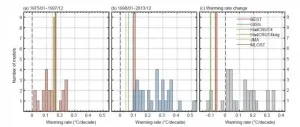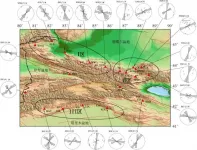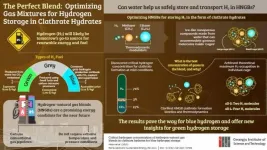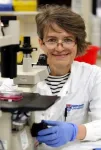(Press-News.org) A weather pattern that pushes snowfall away from parts of Greenland's ice sheet is causing the continent to become darker and warmer, according to Dartmouth research published in Geophysical Research Letters.
The reduction in the amount of fresh, light-colored snow exposes older, darker snow on the surface of the ice sheet. The resulting decrease in reflectivity, known as albedo, causes the ice to absorb more heat, also likely contributing to faster melting.
"As snow ages, even over hours to a few days, you get this reduction in reflectivity, and that's why the fresh snow is so important," said Erich Osterberg, associate professor of earth sciences at Dartmouth and the principal investigator of the study.
According to the research, the decrease in snowfall is the result of "atmospheric blocking" in which persistent high-pressure systems hover over the ice sheet for up to weeks at a time. The systems, which have increased over Greenland since the mid-1990s, push snowstorms to the north, hold warmer air over Western Greenland, and reduce light-blocking cloud cover.
"It's like a triple whammy effect," Osterberg said. "This all contributes to Greenland melting faster and faster."
According to the research, the result isn't only less snowfall, it's a different type of snow on the surface.
As snowflakes melt or evaporate, they become rounded and less reflective than newer, crystal-shaped snow. This causes the snow surface to become darker. According to the research team, a 1% change in reflectivity across Greenland's ice sheet could cause an additional 25 gigatons of ice to be lost over three years.
"Fresh snow looks like what you would draw in a kindergarten class or cut from a piece of paper - it's got all these really sharp points, and that's because it's extremely cold in the atmosphere when the snow falls," said Gabriel Lewis, the first author of the study, who conducted the research as a PhD candidate at Dartmouth. "Once it falls and sits on the surface of the ice sheet in the sun, it changes shape and the snow grains become larger over time."
The team gathered data for the study during a two-summer 2,700-mile snowmobile trek across a region of Greenland's ice sheet known as the western percolation zone.
The researchers found only about 1 part per billion of impurities in the snow. This helped them determine that the changing shape of snowflakes, forced by the persistent high-pressure systems, was the likely cause of the darkening, rather than soot, dust, or microorganisms.
"It's some of the cleanest snow in the world," said Lewis, "In our research area, the impurities do not appear to be enough to account for the change in albedo other research teams have reported."
According to research cited in the study, the Greenland ice sheet has warmed about 2.7 degrees Celsius (4.85 degrees Fahrenheit) since 1982. The continent is experiencing the greatest melt and runoff rates in the last 450 years, at a minimum, and likely the greatest rates in the last 7,000 years.
INFORMATION:
A new study led by Dr. Wei and Dr. Qiao from the First Institute of Oceanography, Ministry of Natural Resources provides an evaluation of the performance of the newly released CMIP6 models in simulating the global warming slowdown observed in the early 2000s. This study reveals that the key in simulating and predicting near-term temperate change is to correctly separate and simulate the two distinct signals, i.e., the human-induced long-term warming trend and natural variabilities, especially those at interannual, interdecadal and multidecadal scales. This work was online published in SCIENCE CHINA Earth Sciences on April 15th, 2021.
After the unprecedented warming over the last quarter of the 20th century, the global surface temperature growth slowed unexpectedly during ...
The collision between the Indian and Eurasian plates resulted in the formation of the Tianshan Tectonic Belt; however, the formation mechanism of Tianshan and the construction of a dynamic model explaining it remain to be achieved and an integrated understanding has not been reached. A new study adopted shear-wave splitting system to collect and analyze shear-wave splitting parameters of 33 stations in the Tianshan area, it provides new evidence for potentially enhance the understanding the dynamic mechanism of the Tianshan tectonic belt.
The research paper is titled:"Anisotropic zoning in the upper crust of the Tianshan Tectonic Belt, Published in Science China Earth Sciences Issue 4, 2021, Corresponding author ...
In our ongoing quest to transform into a more eco-friendly society, hydrogen (H2) is heralded as the clean fuel of tomorrow. Because H2 can be produced from water (H2O) without generating carbon emissions, developing H2-compatible technologies has become a top priority. However, the road ahead is bumpy, and many technical limitations must be ironed out. "Hydrogen is the smallest molecule in nature, and finding feasible ways to store it is a critical issue to realize a hydrogen economy," states Associate Professor Youngjune Park from the Gwangju Institute of Science ...
WASHINGTON, DC--People with cardiovascular disease (CVD) taking aspirin to lower their chances of suffering a heart attack or stroke experienced similar health benefits, including reduced death and hospitalization for heart attack and stroke, whether they took a high or low dose of aspirin, according to a study presented today at ACC.21, the American College of Cardiology's 70th Annual Scientific Session and published in the New England Journal of Medicine.
CVD--and atherosclerosis, in particular, which is a narrowing and hardening of the arteries--is a leading cause of death for men, women, and most racial and ethnic groups in the United States, with estimated direct costs of END ...
New research has shown that people with type 1 diabetes may have features of premature heart disease induced by the condition often before they even get their diagnosis.
Early markers for this heart disease could be used to ensure patients get targeted therapies as soon as they are diagnosed with type 1 diabetes to slow down or even halt cardiovascular problems.
The findings, published in Stem Cell Research and Therapy, show that tiny pieces of genetic material, called miR-424-5p, increased in early stages of heart disease - these could be targeted to help reduce inflammation in order to compensate for elevated risk.
Early heart disease
Dr Jolanta Weaver, from Newcastle University's Faculty of Medical Sciences, UK, ...
There's been a breakthrough in the case of the missing planets.
While planet-hunting missions have discovered thousands of worlds orbiting distant stars, there's a severe scarcity of exoplanets that measure between 1.5 and two times Earth's radius. That's the middle ground between rocky super-Earths and larger, gas-shrouded planets called mini-Neptunes. Since discovering this 'radius gap' in 2017, scientists have been sleuthing out why there are so few midsize heavenly bodies.
The new clue arose from a fresh way of looking at the data. A team of researchers led by the Flatiron Institute's Trevor David investigated whether the radius gap changes as planets age. They divvied up exoplanets into two groups -- young and old -- and reassessed the gap. The ...
The blood thinner apixaban was not superior to standard of care following transcatheter aortic valve replacement (TAVR), according to findings from a new trial called ATLANTIS presented at the American College of Cardiology's 70th Annual Scientific Session. Researchers found that while apixaban reduced the formation of blood clots (thrombosis) around the implanted valve with no increased bleeding risk, a subset of patients taking apixaban who did not have an indication for anticoagulation apart from the TAVR procedure showed a tendency toward a higher rate of non-cardiovascular death--a ...
Transcatheter left atrial appendage occlusion (LAAO) with a WATCHMAN device was associated with a low rate of stroke at one year even among older patients with atrial fibrillation (AFib) who faced a high risk for stroke or bleeding based on their previous health history, according to new data presented at the American College of Cardiology's 70th Annual Scientific Session.
The WATCHMAN device, which blocks a small portion of the heart to help reduce the risk of a dangerous clot forming, was approved by the U.S. Food and Drug Administration in 2015. The device is used to reduce the risk of stroke in patients with AFib, a heart rhythm disorder, that is not caused by problems with the heart valve. ...
Patients with an elevated risk of stroke due to heart rhythm problems, or atrial fibrillation (AFib), were much less likely to suffer a stroke after undergoing heart surgery if doctors concurrently performed an additional procedure, called left atrial appendage occlusion (LAAO), according to the results of a trial presented at the American College of Cardiology's 70th Annual Scientific Session.
AFib increases a person's risk of stroke or systemic embolism, which are life-threatening conditions caused by blood clots blocking an artery. It has been hypothesized that the blood clots that cause these conditions often originate in the left atrial appendage, a small sac on the upper left chamber of the heart. LAAO is a procedure to ...
The heart failure drug sacubitril/valsartan did not significantly reduce the rate of heart failure or cardiovascular death following a heart attack compared to ramipril, an angiotensin converting enzyme (ACE) inhibitor proven effective in improving survival following heart attacks. Findings from the PARADISE-MI trial were presented at the American College of Cardiology's 70th Annual Scientific Session.
The study is the first large trial to examine whether sacubitril/valsartan can reduce heart failure and associated hospitalizations and deaths in patients post-heart attack who face a high risk of developing heart failure. Patients taking sacubitril/valsartan were about 10% less likely than those ...





